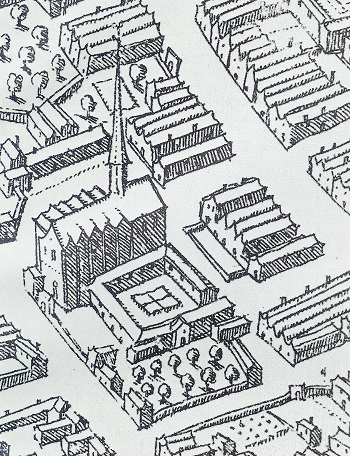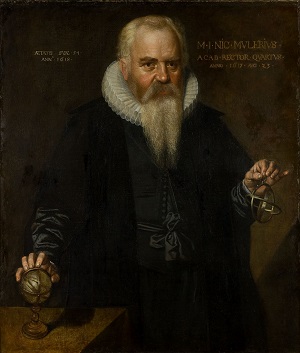Academic Library Groningen, 1615
The Groningen Library is the only university library in the Netherlands that has always remained in the same location. For four centuries, it has stood in the heart of the city — bordered by Broerstraat and Zwanestraat on the north and south , and on the east and west by Poststraat and Oude Kijk in 't Jatstraat. According to an old saying, everything must change if we want everything to stay the same. In the library, too, nothing has remained unchanged for four hundred years.
A short biography of four centuries UB:
The foundation of the UB Groningen
Broerklooster
On 23 October 1613, the learned rector of the Latin school in Groningen, the East Frisian Ubbo Emmius, was appointed professor of history and Greek. Five more professors were recruited in the first months of the following year, after which, on 14 July 1614, the programme of the new university was published and distributed at home and abroad. The inaugural ceremonies took place on 23 August 1614.

Six months later, on 28 February 1615, the Staten van Stad and Lande (the old name for the province of Groningen) decided to establish a library for the academy - and to do so in the former Franciscan monastery, which had been empty since the Reduction of Groningen in 1594, when the Minderbroeders (Friars Minor; Broer refers to the friars, i.e. brothers, broeders in Dutch) had to leave their monastery. The UB's books would be located in the same room where the monks' books once stood.
The building consisted of three wings around a courtyard with the monastery church on the north side. By 1614, when the university was founded, the monastery church had become the academy church. Academic ceremonies, such as disputations, inaugural lectures and promotions, took place in the choir.
Accessibility
All professors signed the first library regulations drawn up by professors Gomarus and Pijnacker, upon which they received a key to the library. Until 1655, when students were allowed to use the library under certain conditions, access to the book collection was the exclusive prerogative of the four curators and professors - in 1614 there were six, in 1655 12 - who themselves could show visitors the treasures using the Syllabus librorum academicorum as a guide.
The library was open only on Wednesdays and Saturdays, from noon to two in winter, from one to three in summer. However, it was not always a delight to study there. The rooms were unheated and only the sun provided illumination. Books had to be consulted on the spot, usually standing up, after placing the large and heavy volumes from the cabinets on desks.

The basic collection
When the decision was taken on 28 February 1615 to establish an academic library, there was not yet a single book. Six months later, on 18 August, Abel Coenders van Helpen, a Groningen administrator who was a member of the States General, handed over the first gift. That was a very beautiful atlas published by Jodocus Hondius, Atlas sive cosmographicae meditationes de fabrica mundi (Amsterdam 1606). Since it is impossible to build a good scholarly library on the basis of mere gifts, several learned and prominent people were enlisted to purchase a basic collection. In Groningen, the book trade was not highly developed, so most of the works for the Academic library were acquired from bookshops and at auctions in Holland.
The titles of these books are listed in the handwritten Syllabus librorum academicorum, or List of academic books. It is the first catalogue of the UB Groningen, compiled by the professor of medicine and mathematics, also unpaid librarian Nicolaus Mulerius. The Syllabus begins with a list of 205 titles in 404 volumes that the library owned - and still owns - on 10 February 1619.
The current building, 1987
In the mid-20th century, the UB was housed in a building from 1919 and a number of connected buildings, enclosed between Martinuskerk, Poststraat, Zwanestraat and Oude Kijk in 't Jatstraat.
From the 1950s, the number of students and staff at the UG increased steadily: in 1955, around 1,000 students were enrolled, in 1980 around 16,000, and today it is more than 30,000. More resources became available for the library to meet the higher demands of education and research. Thus, the size of the book holdings of the UB and the departmental libraries together increased from about 850,000 volumes in 1965 to over two million in 1990. Thousands of books were acquired every year. The number of loans increased constantly and staffing levels had to be adjusted accordingly. The stacks became overcrowded and floors and tables in the workrooms disappeared under the huge stacks of books for which there was no room in the cupboards. Hardly a chair was available for visitors. In the 1980s, even the reading room was sacrificed to make way for the cataloguing department. So a permanent solution was much needed. Eventually, all parties involved came to the conclusion that only a brand new UB could offer solace.

New building
The location of the new building was the major point of contention in the discussions between the Municipality of Groningen and the UG. The University Library Committee, which advised the Board of the University, expressed a preference for a coherent set of library facilities on the site that had been in use as the Hortus Botanicus from the early 17th century until 1966. It is located between Grote Rozenstraat and Grote Kruisstraat, just north of Broerstraat. This proposal had the full support of the librarian and his team, as there would be enough space for a modern, well-equipped library building. However, the city council insisted on a much smaller location, namely in the vacant St Martinus church on Broerstraat, opposite the Academy Building. After all, a library there would attract many visitors and create more activity in the city centre. The argument that the site was too small to erect an efficient building of the required size was ignored. When, after long and arduous deliberations, the Board and Council suddenly came to an agreement on the Martinus church site, it took another two years until, in early 1979, permission was received from The Hague to build on this spot.
More information
-
The University Library of Groningen : four hundred years of history in four buildings, forty collections and infinite pictures, by Gerda Huisman. Published on the occasion of the 400th anniversary of the UB
-
Syllabus librorum academicorum, the earliest catalogue of the UB Groningen from 1619
| Last modified: | 09 January 2024 3.44 p.m. |

